COVID-19 is fast-tracking the industry’s slow move from fewer in-person HCP visits to digital and virtual approaches.
COVID-19 has driven vast changes in what healthcare providers need and value from pharma companies, and as a result, the industry is striving to develop new 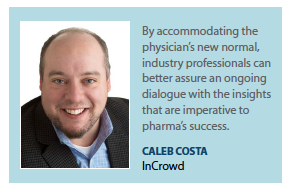 ways to engage with physicians. Experts say this is just the beginning of a long journey and as the health ecosystem continues to morph, so will pharma interactions with HCPs.
ways to engage with physicians. Experts say this is just the beginning of a long journey and as the health ecosystem continues to morph, so will pharma interactions with HCPs.
According to a recent Accenture report on how COVID has forced changes between HCP and rep interactions, pharma companies are starting to redefine their role in this new landscape, and healthcare providers are realizing the value a rep can bring to the table.
As HCPs shift to more virtual interactions with both patients and pharma companies, a vast majority of HCPs report they have seen pharma companies change what they communicate about — beyond just product information. Healthcare providers said the services that pharma companies are offering now are of higher value than before COVID-19.
The upshot: virtual engagement with HCPs is here to stay, requiring sales teams to create new ways of making meaningful connections.
According to Accenture’s research, before COVID-19, 64% of meetings with pharma sales reps were held in person. During the pandemic, this shifted to 65% of meetings held virtually, consistent across therapeutic areas. According to Accenture, 87% of HCPs want either all virtual or a mix of virtual and in-person meetings even after the pandemic ends.
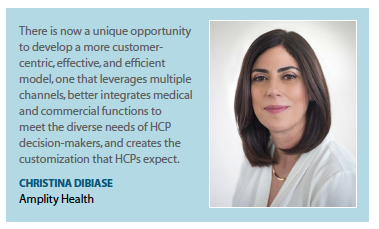 After conducting research with more than 100 patients and 100 physicians and hosting a virtual roundtable discussion with biopharma executives, the consulting firm ZS is advising industry to expect long-term modifications to the pharma selling model. ZS polls show that 70% of the reps are back working, but their activity is about half of what it used to be in terms of the number of calls. This means total rep activity is actually only 35% to 40% of pre-COVID levels. So, while reps are still participating, they’re using teleconferencing or video conferencing in some form.
After conducting research with more than 100 patients and 100 physicians and hosting a virtual roundtable discussion with biopharma executives, the consulting firm ZS is advising industry to expect long-term modifications to the pharma selling model. ZS polls show that 70% of the reps are back working, but their activity is about half of what it used to be in terms of the number of calls. This means total rep activity is actually only 35% to 40% of pre-COVID levels. So, while reps are still participating, they’re using teleconferencing or video conferencing in some form.
According to Pratap Khedkar, managing principal, ZS, currently two-thirds of sales rep activity is virtual calls and only one-third are being conducted face-to-face. He estimates that face-to-face calls are down at least 90%.
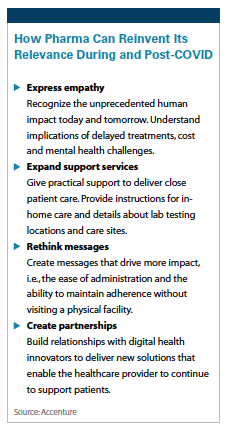 “We are seeing a shift from quantity to quality because rather than having short interactions many times a month or many times a year with a doc, interactions will become longer, but much less frequent," he says. “Reps may be able to interact in-person every six weeks to eight weeks but the days of dropping in every week are over."
“We are seeing a shift from quantity to quality because rather than having short interactions many times a month or many times a year with a doc, interactions will become longer, but much less frequent," he says. “Reps may be able to interact in-person every six weeks to eight weeks but the days of dropping in every week are over."
Virtual Engagement Will Continue Post-COVID
More than 40% of HCPs said they are restricting who can enter the office for professional reasons — no pharmaceutical reps — with 28% planning to make this change permanent. “COVID-19 has greatly accelerated already-strong trends driving greater virtual engagement," says Paul Mignon, president, Syneos Health Deployment Solutions. “Over a five-day period in March, our Syneos Health Deployment Solutions teams essentially flipped a switch and moved sales reps from 99% face-to-face interactions to more than 90% virtual. We made a swift and effective transition to video calls and virtual detailing thanks to the education, training, and learning resources available, and to our relationships with medical teams."
Reps have been using CRM add-on capabilities to help fill the gap caused by the lack of physician access due to COVID-19. This allows representatives to conduct physician calls virtually by phone and/or video in addition to email and text.
In addition, due to social distancing and increased safety measures, doctors are changing how they work, notes Steve LoSardo, VP, healthcare solutions at Mobiquity.
“In some cases, they don’t have the same traditional hours that they did pre-COVID, which allows them to see more patients virtually, either over the phone or via video visit," Mr. LoSardo says. “This has also impacted pharma representative access, however recent surveys indicate that physicians still want some interaction with sales representatives, particularly in relation to product information and drug samples."
“If anyone had doubts about the power of virtual engagement, telemedicine, and digital health, COVID-19 has laid them to rest," Mr. Mignon says. “The sudden move to virtual has drawn sales reps deeper into the world of non-personal promotion and the use of advanced tools for reaching physicians through multiple touchpoints, using the methods and media they prefer."
However, sales reps may be hesitant to engage with physicians through virtual visits, or they may just prefer to do face-to-face, as that is the skill they know. Mr. Khedkar says anecdotal sentiment analysis showed 58% of sales reps basically had a negative sentiment around digital and only 6% had a positive sentiment. “If we look at the data qualitatively, sales reps are not too excited about making the pivot," he says.
This makes Mr. Khedkar believe the transformation to virtual visits will be a long journey for some in the industry. No company has it completely figured out, but many are taking steps. The first step many companies took was empathy training, with some organizations jumping in within a week of the start of the lockdown.
This type of training entails teaching reps to understand the physicians’ circumstances and show compassion and responsiveness to their situation before ever mentioning a product.
“First of all, reps need to know how to talk to physicians with empathy to find out how they’re feeling, what their needs are, is there anything they can do to help and not jump to the product message, which is how they’ve all been trained," Mr. Khedkar says. “So, one part is unlearning to do what they’ve always been doing."
Christina DiBiase, chief commercial officer at Amplity, agrees that empathy is going to be key going forward.
“Engaging HCPs in the early months of the pandemic required a focus and energy on interpersonal relationships," she says. “The feedback we received from physicians, about what they valued most from pharma reps during COVID, was focused on three key areas: a rep’s ability to express empathy, more patient-centered dialogue, and active listening to identify additional support services. There is a greater emphasis now than ever before on a pharma rep’s ability to demonstrate relevance for the HCP and their patients."
Best Practices to Reach Physicians Post-COVID
Reaching physicians in the future won’t move to all virtual and digital; in-person contact will remain an important tool in the sales rep toolbox. It just won’t be used as often.
According to Mr. Khedkar, a best practice would be the right mix of the three modes: in-person, virtual, and digital, ie, emails and apps, tailored to the preferences of the physician.
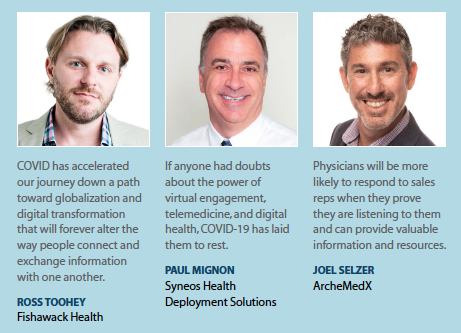 “COVID has accelerated our journey down a path toward globalization and digital transformation that will forever alter the way people connect and exchange information with one another," says Ross Toohey, chief commercial officer, Fishawack Health. “We believe that the greatest change won’t be in which channels become more predominant, but rather how we use them, and what we expect them to accomplish."
“COVID has accelerated our journey down a path toward globalization and digital transformation that will forever alter the way people connect and exchange information with one another," says Ross Toohey, chief commercial officer, Fishawack Health. “We believe that the greatest change won’t be in which channels become more predominant, but rather how we use them, and what we expect them to accomplish."
Mr. Toohey suggests a best practice would include a thorough reevaluation of the paradigms of HCP engagement in a post-COVID world, with emphasis on training and empowering sales teams to better deploy technologies.
InCrowd conducted COVID-19 syndicated studies that show digital communications, preferably those suitable for on-the-go responses, are preferred by physicians now during the pandemic and in the foreseeable future. “According to data sourced since the pandemic began, physicians at the frontlines of COVID-19 care — PCPs, pediatricians, and ER and critical care specialists —have emphasized that they need dialogues to be fast, simple, and convenient," says Caleb Costa, chief commercial officer, InCrowd.
One advantage of a virtual call is that it can bring multiple stakeholders together at the same time, enriching both the content and the value of the call. Physicians can invite their nurse practitioners, office managers, or even peers, and at the same time, reps can have MSLs or patient educators on the call.
According to ZS surveys, 12% of the time a rep invites a patient educator to the virtual call, and depending on the area, about 20%-23% of the time the rep brings along an MSL.
“Suddenly the rep can do something he or she could never do before, which is to do a multi-stakeholder call," Mr. Khedkar says. “These types of calls are far more productive and feel like a team meeting. And, often the average length of the call is a much longer time period than they could achieve in person."
A multi-stakeholder call also creates greater opportunities for follow ups, as it often becomes a string of interactions, which is sometimes virtual, sometimes in-person, sometimes through email or an app and it sets up a dialogue over time with 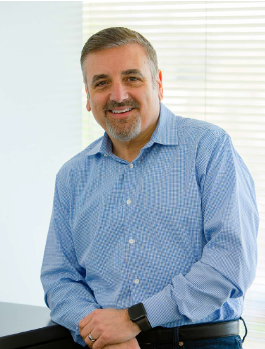 multiple people. Mr. Khedkar says this model provides a level of richness that adds more value to the doctor’s office. “Physicians now can have a team solving their problems as opposed to one person who is not able to do everything," he says.
multiple people. Mr. Khedkar says this model provides a level of richness that adds more value to the doctor’s office. “Physicians now can have a team solving their problems as opposed to one person who is not able to do everything," he says.
Technology Enhancements
Smart devices are being used more frequently during COVID as a way for reps to stay in touch with physicians. These types of IoT powered devices can also help representatives cover more territory, they can break down communication barriers to office visits, enhance professional 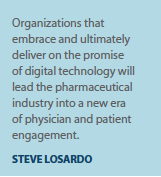 consultations, and augment product orders.
consultations, and augment product orders.
And they can be programmed to execute custom functions at the push of the button, eliminating the need for calls, video conference sessions, or multiple emails for sample requests, meeting requests, MSL consultations, and more. “IoT-powered smart devices are enabling a reimagining of the world of pharma-to-physician communications by fundamentally changing the way marketers and sales organizations interact with customers and prospects," says Anupam Nandwana, CEO of P360. “These solutions not only save organizations time and money; they give them a new digital channel of engagement for meaningful interactions — think a pharma version of Google Home, only smaller."
Mr. Nandwana says COVID has forced the industry to reevaluate the user experience across multiple touchpoints and come up with a hybrid model for the future, where remote engagements precede the in-person meetings.
The challenge is in the use of proprietary platforms that don’t integrate with other systems. Physicians will require a common user interface (UI) for connecting with various services. The adaptability of these platforms is dependent on how user friendly they are, and what value they bring to the physicians.
Also, the market is currently being flooded with apps and portals for reaching physicians. There are many different systems, making it difficult for physicians to remember which ones go with which vendors. “All are great efforts, but they create an overwhelming experience for physicians — even more so after the COVID-19 pandemic began," Mr. Nandwana says. “Pharma companies need something that makes their brand stand out, and that differentiates their user experience from the competition. This can be done via branded smart devices."
All these methods will be used in the future, and the trick will be to stand out in the crowded arena of virtual connections and messaging. While email, apps, SMS, immersive digital platforms, and learning experiences will all be used in a complementary way to increase awareness and understanding of new treatments, the ideal way to reach physicians will always be to become more discoverable. “In other words, make your brand easy to find," says Joel Selzer, CEO of ArcheMedX.
Building Relationships Virtually
It is obvious that the sales dynamic between pharma and physicians is changing permanently. Physicians are now in the driver’s seat regarding their interactions with pharma, Mr. Nandwana says. “Gone are the days when a rep can just show up in an HCP office unannounced," he adds. “Before COVID-19, the tide was shifting toward minimizing in-person rep visits, with some healthcare institutions completely banning reps. Now, after COVID-19, physicians really set the rules on when to engage pharma."
Sending reps to the physician’s office on a fixed reach and frequency goal, with a predefined number of visits, is not going to be possible any longer. Physicians still welcome the contact, but interactions need to be at their pace. Alternative channels, messaging, and options are required. Most of the communication today is being done via push methods. The need for pull options will increase, and this is where AI, machine learning, advanced analytics, and other technologies will be very helpful.
“Sales reps need to understand the systems physicians are using, or that they are moving to, and evolve within this new paradigm," Mr. Nandwana says. “The sales rep of the future should know the ins and outs of digital technology and find opportunities for connection points using those new tools."
According to a report by consultant firm HawkPartners, there will always be a need for in-person rep meetings, dinners, and conferences in the new pharma sales model, but the COVID-19 crisis has accelerated the need to adapt using alternative methods. Digital channels will play a prominent role as HCP adoption and comfort levels accelerate.
“Face-to-face human interaction will always be the best way to forge deep, lasting relationships with HCPs," Mr. Toohey says. “Humans are inherently social creatures, and no technology will permanently displace the fundamental mechanisms of community."
Relationships are built on trust and that must continue, regardless of the channel. “Going virtual doesn’t mean we stop being human," Mr. Selzer says. “Physicians will search for the most trusted and effective solutions for their patients and will still need assistance."
The difference today is that more physicians are open to engaging virtually and they are generating more data. This enables commercial teams to build data-driven approaches that inform and shape their interactions with physicians around identified needs. They’ll be better prepared to reach out based on past behavior, with a timely and contextually relevant message or resource, to engage the right physician at the right moment, Mr. Selzer says.
The development of HCP relationships through virtual interactions requires an engagement model that is tailored to customer needs, one that is flexible, coordinated, leverages the benefits of remote and in-person promotion, optimizes promotional mix across personal and non-personal channels, and provides relevant, timely and credible information to HCPs, Ms. DiBiase says. The new virtual model requires new skills and expertise and the rapid adoption of new technologies. It has real potential to revolutionize how pharma engages with customers, allowing customer expectations to be exceeded and improving business performance.
HCPs benefit from effective two-way engagements with representatives for credible information and patient support. These needs vary dramatically based on therapeutic area, stage in the product life cycle, geography, HCP role in decision-making, affiliation, and personal preferences.
“By adjusting to the HCPs’ preferred ways of engaging, sales teams can develop strong relationships virtually by meeting physicians where they are on the product adoption continuum and utilizing the channels they respond to best," Ms. DiBiase says.
“In many conversations over the past few weeks, sales reps have told me how friendship and comradery with physicians — often built up over years of face-to-face contact — were the key to sustained virtual engagement with health systems and practices that closed in March," Mr. Mignon says. What that means is that whether virtual or face-to-face, field engagement is still all about relationships.
According to some pharma companies, there is a belief that sales representatives who already have strong relationships with HCPs will be able to successfully continue them virtually. The level of familiarity and trust are keys here. The concern, however, is how to determine the best cadence for reaching out to HCPs digitally and not inundating them with virtual meeting requests, emails, etc. “These reps will need to use digital technology in a way that gives them an advantage over their competition," Mr. LoSardo says. “Is a weekly email more beneficial than a video Zoom call? What tactics will help them stand out? Figuring out the answers to these questions will determine a pharma company’s success promoting to physicians digitally."
According to InCrowd, the virtual sales call is and will continue to be critical to maintaining the pharma/clinician connection. InCrowd physician tracking data show that 47% of frontline COVID-19 treating physicians and 69% of specialists are willing to meet virtually this year, compared with 34% of frontline treaters and 53% of specialists who’d take an in-person meeting. “Telehealth’s rapid adoption has driven familiarity and underscored the benefits of virtual dialogues across the board," Mr. Costa says.
Some of the tools that should be considered are artificial intelligence/machine learning, personalization, mobile apps, voice, physician portals, etc. “Regardless of which of these tools are implemented, reps need to focus their efforts on helping physicians get access to and provide value for the patient," Mr. LoSardo says. “This is the key to building a meaningful relationship with HCPs."
Mr. Toohey of Fishawack Health believes the balance of rep to HCP interaction will shift dramatically toward knowledge sharing, information distribution, patient support, and compliance. With sample delivery and patient education asset distribution being handled by alternative mechanisms, which he believes will absolutely carry on beyond COVID, sales organizations will need to reengineer the value they provide HCPs during interactions.
“COVID wrecked the legacy perceptions HCPs had of sales teams," he says. “For HCPs to commit the time to a virtual interaction, they’ll need to see real value in exchange."
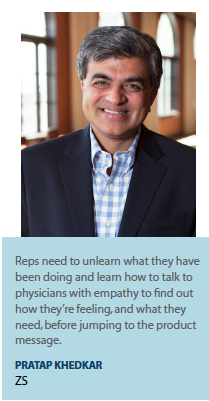 Using advanced omnichannel technology to look at each physician holistically, understand each interaction with digital media, measure each impression, and assess each stimulus is the way to develop strong relationships with physicians, Mr. Mignon says. “We can use insights from behavioral sciences to calibrate engagement so that the right information flows from product innovator to provider to patient without distracting or swamping medical teams on the front lines," he adds.
Using advanced omnichannel technology to look at each physician holistically, understand each interaction with digital media, measure each impression, and assess each stimulus is the way to develop strong relationships with physicians, Mr. Mignon says. “We can use insights from behavioral sciences to calibrate engagement so that the right information flows from product innovator to provider to patient without distracting or swamping medical teams on the front lines," he adds.
The way to be tech-enabled but still relationship-first is to design engagements that the physician can control — perhaps engaging briefly at one moment, then allowing him or her to come back to go deeper into the information at a convenient time, he says.
Reps Need to Support Physicians More Than Ever
To provide support that physicians need and want, several pharmaceutical companies are looking at a model that puts the pharma rep at the center of all digital engagements, acting as a coordinator for all their digital channels, as well as for the company’s various pharma teams — medical science liaisons, key account managers, consumer reps, etc., Mr. LoSardo says. This ensures that HCPs receive the appropriate level of coverage and interaction with the goal of creating synergies across all communication channels. “It’s all about refocusing the pharma reps’ efforts so that there is more efficiency, increased engagement, and effective use of digital tools because, truth be told, there is no time to waste," he adds. “As an industry, healthcare and life-science companies need to find more innovative ways to help patients live healthier lives and it’s exciting to see the transformation that organizations are making in order to achieve that goal."
Rethinking the process between marketing, clinical research, legal, medical affairs, and other functions within a pharma company will be necessary as a way to share new information and products with HCPs.
Several surveys have showed that physicians – especially during the pandemic – feel they are not being heard, by anyone. This is important for reps to note, and to do what they can to help physicians get the resources and tools they need to continue functioning under the pressures of life during COVID.
ZS surveyed physicians and asked them what they needed from sales reps. About 27% of the 400 reported being satisfied with the support from their reps during  COVID. What they noted was reps were proactively informing them about patient-support programs and helping them solve issues: for example, delivering samples to a patient’s house.
COVID. What they noted was reps were proactively informing them about patient-support programs and helping them solve issues: for example, delivering samples to a patient’s house.
“These were the types of challenges that pharma was able to address that physicians and administrators liked," Mr. Khedkar says. “When physicians reported they were not happy, it was because these types of things were not happening. In fact, one of the quotes was: reps are not reaching out to us verbally or virtually, it’s like they just disappeared off the face of the map."
This is an important lesson for pharma, he says. “Always be in touch. Be proactive. This is a big part of the relationship building equation. Don’t push the product message at this time, but instead find out if you can assist them in any way."
“To succeed in the post-COVID world, the rep must be viewed by the HCP as a thinking partner," Mr. Toohey says. “To achieve this will require substantial salesforce retraining and upskilling."
At P360, studies indicate more than 80% of physicians prefer virtual services as an option to start the engagement journey, with more traditional modes of engagement following as wanted. This means using the communication channels preferred by physicians is key right now — so learning those preferences is critical.
And there will be no going back now that virtual relationships and interactions have become the new normal. “HCPs are not fully expecting to go back to the old ways of pre-COVID engagement," Ms. DiBiase says. “They have seen great value and benefit from effective two-way virtual engagement with credible information and patient support. There is now a unique opportunity to develop a more customer-centric, effective, and efficient model, one that leverages multiple channels, better integrates medical and commercial functions to meet the diverse needs of HCP decision-makers, and creates the customization that HCPs expect."(PV)


















